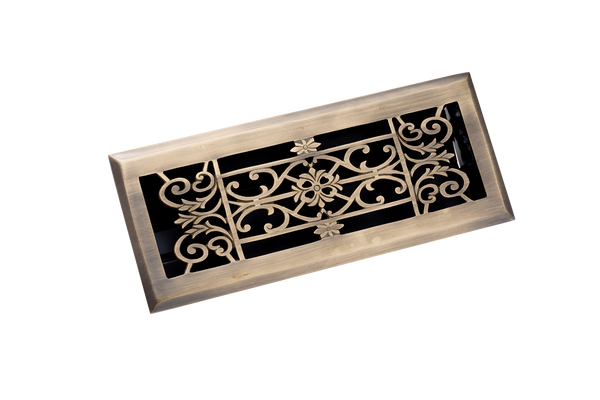When it comes to home decor, often the focus is on paint colors, furniture, and lighting. But what about those small details that can elevate your space? Decorative floor registers are one such detail that often gets overlooked. However, they can transform a basic room into an aesthetically pleasing area, enhancing not just the functionality but also the visual appeal of your home. In this guide, we will explore everything you need to know about decorative floor registers—from their types and materials to installation tips and maintenance.
What Are Decorative Floor Registers?
Decorative floor registers are covers designed to shield HVAC vents and ducts while allowing airflow into a room. Unlike standard metal grates, these registers come in various styles, colors, patterns, and materials, making them a decorative element in any home. My journey into the world of decorative registers started when I wanted to remodel my living room; a simple change in registers made a world of difference!
The Importance of Decorative Floor Registers
Not only do decorative floor registers add visual flair, but they also serve several practical purposes:
- Functionality: They allow for optimal airflow in your space, ensuring that the heating and cooling system operates efficiently.
- Safety: A well-fitted register keeps debris out of the ductwork, improving air quality.
- Aesthetic Appeal: They can complement your decor style, adding a polished look to your home.
Types of Decorative Floor Registers
With a variety of styles and materials available, here’s a breakdown of the most common types of decorative floor registers.
1. Wooden Decorative Registers
Wooden registers offer a warm, classic look that fits well with traditional or rustic interiors. They can be stained or painted to match your floor, providing seamless integration with your home’s decor.
Pros:
- Available in various wood types.
- Customizable in terms of color and finish.
- Durable with proper maintenance.

Cons:
- Can warp or crack over time.
- Higher initial cost compared to metal options.
2. Metal Decorative Registers
Metal registers are both durable and stylish. They come in various finishes, including bronze, nickel, and chrome, suitable for contemporary and industrial designs.

Pros:
- Long-lasting and resistant to damage.
- Available in many finishes.
- Easy to clean and maintain.
Cons:
- Can be noisy if not properly installed.
- May require regular polishing to maintain the finish.

3. Plastic Decorative Registers
Plastic registers are lightweight and inexpensive. They come in a variety of colors and are often used in rental properties due to their low cost and ease of installation.
Pros:
- Affordable and readily available.
- Easy to install and replace.
- Available in many colors.

Cons:
- Less durable than wood or metal.
- May not offer the same aesthetic appeal.
Choosing the Right Decorative Floor Register
When selecting a decorative floor register, consider the following factors:
1. Style
Determine the overall style of your home. Is it modern, traditional, eclectic, or minimalist? Choose a register that complements your decor.

2. Size
Ensure that the register fits the space appropriately. Measure the existing duct opening to find a compatible size.
3. Material
Consider the room’s usage and environment. For example, a humid bathroom may not be ideal for wooden registers, while a living room could beautifully accommodate them.

Installation Tips for Decorative Floor Registers
Installing a decorative floor register can be a straightforward DIY project. Here’s a step-by-step guide:
Tools Required
- Measuring tape
- Screwdriver
- Level
- Utility knife (if necessary)
Steps to Install
- Remove the existing register by unscrewing it from the floor.
- Clean the area around the duct to remove dust and debris.
- Measure the duct opening and ensure your new register fits.
- Place the new register over the duct, ensuring it’s aligned properly.
- Screw the register into place using a screwdriver.
- Check for levelness and adjust if necessary.

Maintaining Your Decorative Floor Registers
Proper maintenance will prolong the life of your decorative floor registers. Here are a few tips:
Cleaning
Dust and vacuum your registers regularly to keep them clean. Use a damp cloth to wipe down metal and wooden registers, and avoid harsh chemicals that may damage the finish.
Inspection
Periodically inspect your registers for any signs of damage or wear. Look for rust on metal registers or warping in wooden ones. Addressing issues early can prevent more significant problems down the line.
| Type | Durability | Aesthetic | Cost |
|---|---|---|---|
| Wooden | Medium | Classic/Rustic | $$$ |
| Metal | High | Modern/Industrial | $$ |
| Plastic | Low | Functional | $ |
Common FAQs about Decorative Floor Registers
1. Can I install decorative floor registers myself?
Yes! Installing decorative floor registers is generally a DIY-friendly task. With basic tools and some measuring, you can easily change them out.
2. Are decorative floor registers suitable for all rooms?
While decorative floor registers can be used in most rooms, consider humidity levels. For example, in bathrooms, opt for moisture-resistant materials.
3. How do I know the right size register for my duct?
Measure the existing duct’s width and length to determine the size. Registers come in standard sizes, so you should be able to find a suitable match.
4. What are some popular styles for decorative floor registers?
Popular styles include vintage, modern, ornate, and minimalist. The choice largely depends on your personal taste and the overall theme of your home decor.
5. Can decorative floor registers affect airflow?
While they are designed to enhance airflow, poorly sized or blocked registers can restrict it. Ensure they fit properly and keep them unobstructed.
Conclusion
Decorative floor registers are a small yet impactful element of home design that can elevate any space. Whether you choose wooden, metal, or plastic options, the right decorative register can seamlessly blend functionality with style. As you embark on your home improvement journey, consider how decorative floor registers can enhance your living environment. Happy decorating!